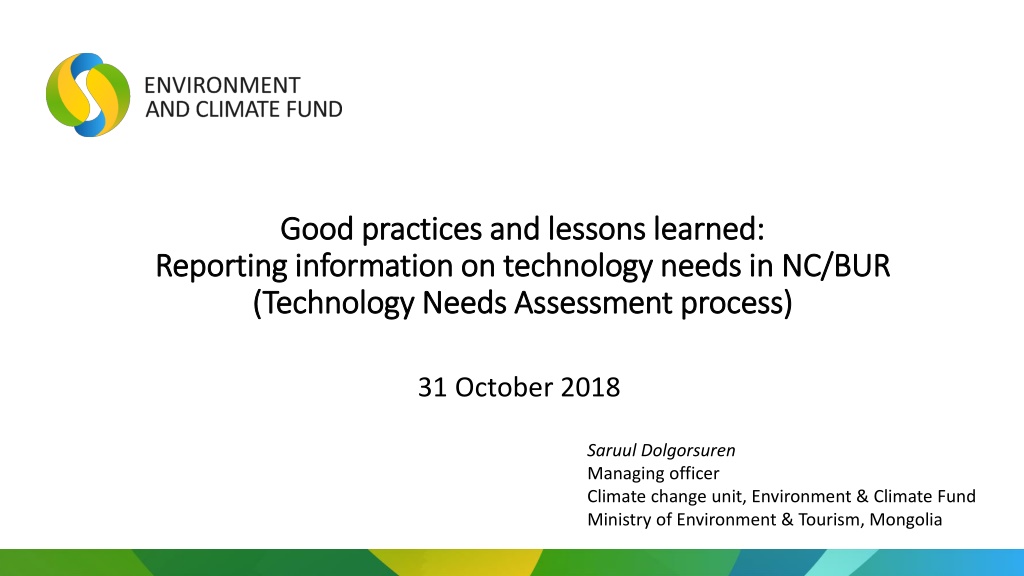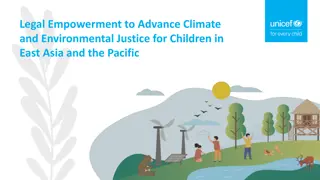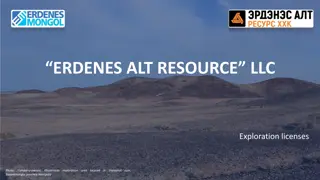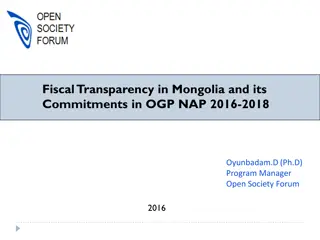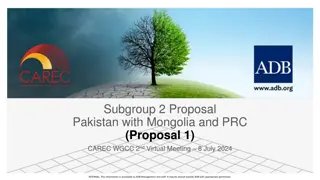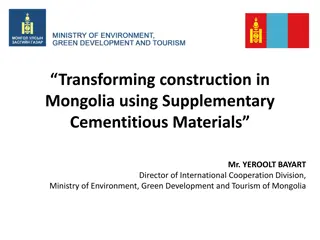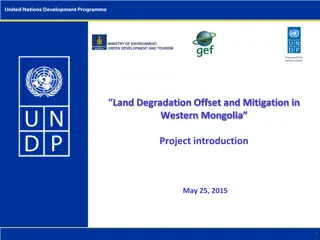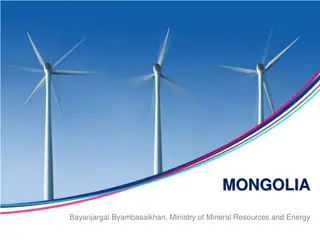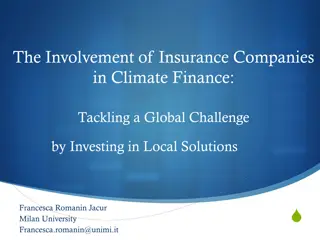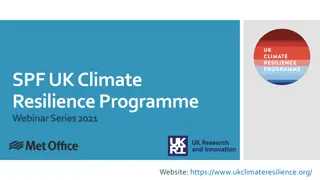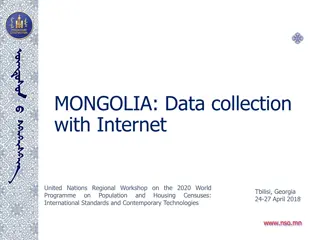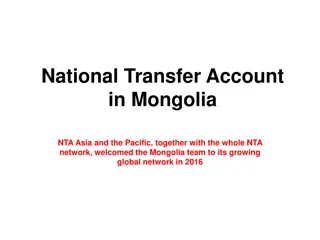Climate Technology Policies and Initiatives in Mongolia
Mongolia has implemented various climate technology policies and initiatives to address environmental challenges and promote sustainable development. These include laws on technology transfer, innovation, and environmental conservation, as well as national programs focusing on low-carbon economies, green growth, and renewable energy expansion. The country aims to increase its renewable energy capacity and energy efficiency while adapting to climate change impacts through a range of legislative measures and strategic plans.
Download Presentation

Please find below an Image/Link to download the presentation.
The content on the website is provided AS IS for your information and personal use only. It may not be sold, licensed, or shared on other websites without obtaining consent from the author. Download presentation by click this link. If you encounter any issues during the download, it is possible that the publisher has removed the file from their server.
E N D
Presentation Transcript
Good practices and lessons learned: Good practices and lessons learned: Reporting information on technology needs in NC/BUR Reporting information on technology needs in NC/BUR (Technology Needs Assessment process) (Technology Needs Assessment process) 31 October 2018 Saruul Dolgorsuren Managing officer Climate change unit, Environment & Climate Fund Ministry of Environment & Tourism, Mongolia
COUNTRY PROFILE FACTS Annual mean T 2.24 C/1940-2015, compared with 1961-1990/ Annual precipitation 7.3% /1940-2015, compared with 1961-1990/ Coal reserves: 173B.tons Primary source of energy: coal Landscapes and climate: diverse and vulnerable Total Inst. Capacity CHP 90% Resource dependent economy: setbacks and declines RE 6% Diesel 2% Hydro 2% 2
COUNTRY PROFILE: Mongolias total GHG emissions/removals (Gg 2e)
KEY CLIMATE KEY CLIMATE POLICY FRAMEWORKS POLICY FRAMEWORKS National Action Programme on Climate Change (2011-2021) A low carbon economy thru environmental technologies and EE A foundation for green economic growth and development Capacity building in all areas incl. M&E, and research networks Green Development Policy (2014-2030) transform to a green and environmentally friendly development support clean and advanced technologies thru incentives UB metro, bus rapid transit service for public transportation Mongolia s Nationally Determined Contributions (INDCs) Increase RE capacity from 7.62% to 20% by 2020, and 30% by 2030 Increase EE by reducing electricity transmission losses, heat losses thru applications of advanced technologies Mongolia s Sustainable Development Vision (2015-2030) Develop RE sector Adapt to climate change impacts 4
Climate technology related policy and legislation Law on Technology transfer, 1998 Technology assessment Law on Science and Technology, 2006 Law on Innovation, 2012 Law on Environmental Conservation, 2012 Identified 41 technologies that will release of charge on VAT (government decree No303, 2013) Master Plan on Development of Science and Technology 2007-2020 Core technology list of Priorities of Development on Science and Technology 2015-2021 (government decree No368, 2015) Green Development Policy, its implementation plan 2016-2030, 2016 National Action Programme on Climate Change Other sectorial development plans and strategies
Institutional arrangement of TNC and BUR1 Institutional arrangement of TNC and BUR1 by 2017 by 2017 GOVERNMENT OF MONGOLIA MINISTRY OF ENVIRONMENT AND TOURISM PROJECT STEERING COMMITTEE National Project Director Environment and Climate Fund CLIMATE CHANGE PROJECT IMPLEMENTING UNIT Advisor for methodology and science GEF/UNEP Third National Communication (TNC) First Biennial Update Report (BUR) Joint Crediting Mechanism (JCM) Ad hog consultant groups (2) Ad hog consultant groups (2)
Institutional arrangement for the TNA Institutional arrangement for the TNA project (by 2013) (by 2013) project Ministry of Nature, Environment and Tourism (MNET) TNA Coordinator (Director of Climate Change Coordination Office) National TNA Committee/ Steering Committee Working Group on Mitigation Working Group on Adaptation Short term consultants Source: TNA, 2013
Capacity building activities under support of international partners which Capacity building activities under support of international partners which strongly linked to technology accelerations on climate change : strongly linked to technology accelerations on climate change : In 2017, Mongolia has become a member, and jointly organized the National Forum on NDC in Oct. 2017 engaging stakeholders, in 2018 other Since 2013, under the Joint Credit Mechanism, varies workshops for local stakeholders including the private sector more than 200 Joint ADB-UNEP Project Pilot Asia-Pacific Climate Technology Network and Finance Center (CTCN) 2014; TA: Integration of Climate Technology Financing Needs into National Development Strategies, Plans and Investments Priorities 2015 Since 2013, under PAGE varies activities conducted in areas construction, sustainable procurement, green economy learning and sustainable finance. of as green public 2017-2018, AIT co-organized trainings on: Economics of Climate Change Adaptation Mainstreaming gender in adaptation planning GCF Concept Development Together introducing GCF and accreditation process, included the private sector with GIZ, workshops on 2015-2017, supported project on BUR and TNC, local and regional workshops organized on GHG inventory, mitigation and adaptation planning and transparency under the GEF-UNEP In 2018, under the GCF Readiness projects on (i) NDA Capacity Building (XacBank) and (ii) Developing country program; varies training and workshop are being organized engaging wider stakeholders
BUR BUR ICA report ICA report Mongolia reported information on its technology needs and the technology support received. This information was presented in its BUR1 with cross references to its NC2. Further, during the technical analysis, Mongolia clarified that there is a strong need to undertake a further TNA. In 2013 the Government of Mongolia conducted a TNA on mitigation and adaptation with the support of the GEF through the United Nations Environment Programme. However, the information included in the 2013 TNA needs to be updated and amended consistent with emerging international and domestic climate change policies and strategies. Mongolia will require enhanced financial and technical support to conduct a new TNA. In consultation with Mongolia, the TTE identified the following capacity-building needs related to the facilitation of the preparation of subsequent BURs and participation in ICA: To enhance the institutional arrangements and coordination for the development of the national MRV system; To obtain financial and technical support to conduct a new TNA.
Thank you for your attention! SARUUL Dolgorsuren Managing officer Climate Change Project Implementing Unit (CCPIU) Environment and Climate Fund (ECF) Ministry of Environment and Tourism Suite 22-7G, Amar Street, 8th khoroo Ulaanbaatar-14200, Mongolia E-mail: saruulsh@gmail.com
